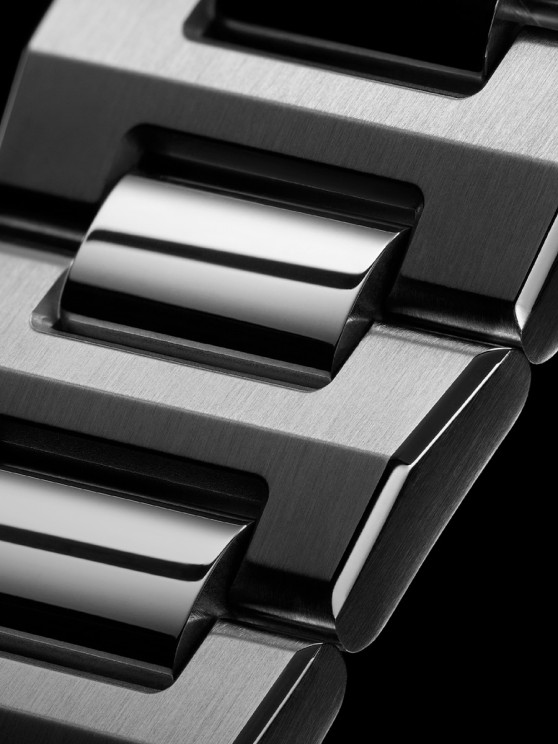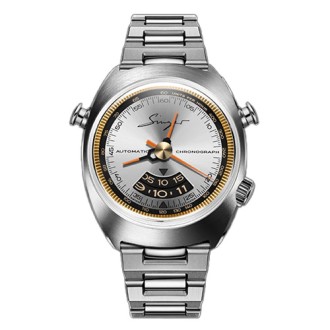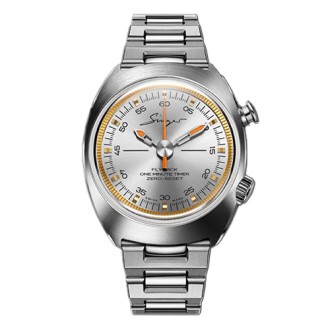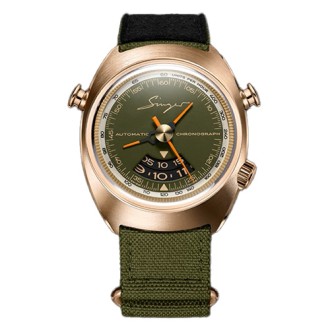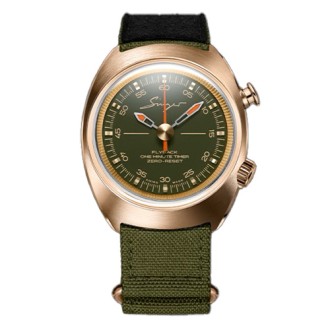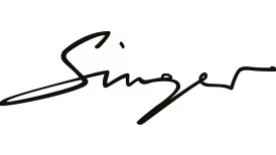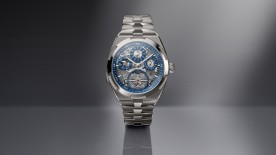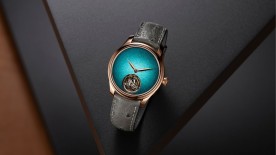This time last year, Geneva watchmaker Singer Reimagined was taking a nostalgia-soaked trip as it unveiled the debut pieces in its 1969 collection.
These fresh interpretations of the brand’s retro-tinged Chronograph and Timer watches featured more compact 40mm cases and cleaner, more readable dials – compared to Singer’s previously released Track 1 and Flytrack – made possible by the revised engineering of their impressive movements made by Jean-Marc Wiederrecht and his team at Agenhor.

Singer Reimagined has now followed up those initial 1969 pieces – which were in stainless steel with black lacquer dials – by launching eye-catching bronze-cased editions of its 1969 Chronograph and 1969 Timer. Both boast dials and technical textile straps in khaki green, while their casebacks – the part that touches the wrist – are in hypoallergenic titanium.
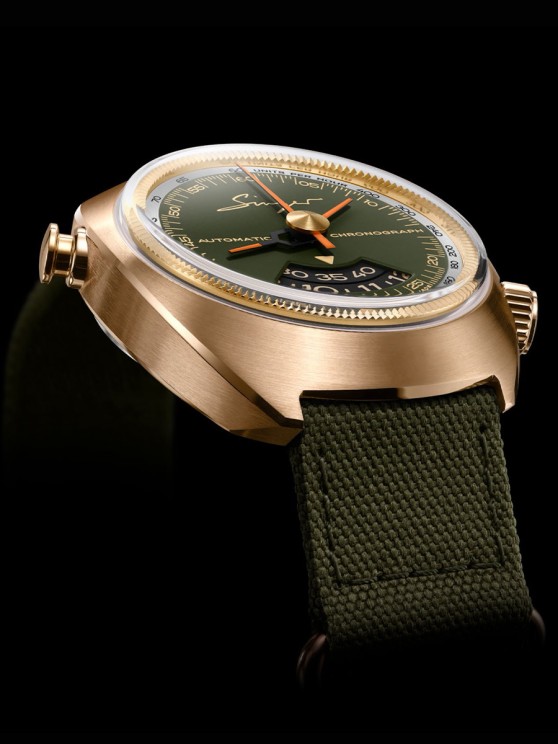
And that’s not all: The brand has also taken the opportunity to update its 1969 offering in stainless steel, with the Chronograph and Timer now available with sunray-decorated silver dial. Both these models are paired with the H-link stainless-steel bracelet that was introduced on the launch of the 1969 collection last year.
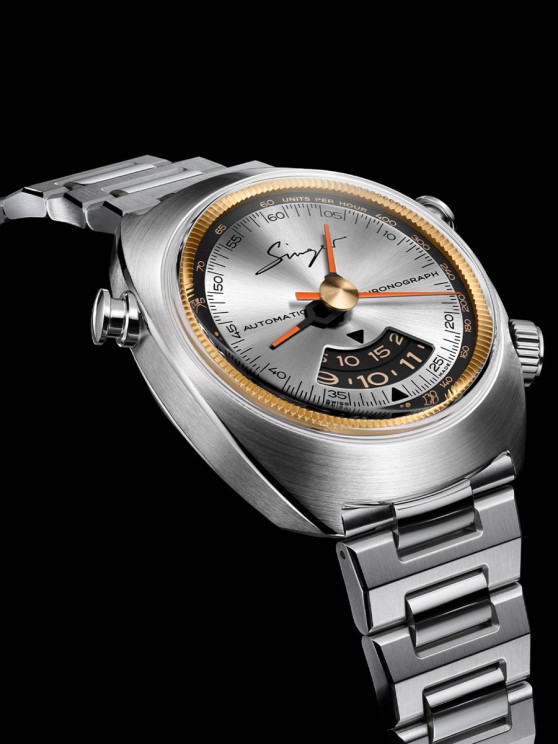
We sat down with Singer Reimagined’s co-founder, creative director and designer Marco Borraccino to talk about the intricacies of these updates.
Marco, it’s a year since Singer unveiled its 1969 collection. What has the reaction to it been like?
It has been great. Thanks to the smaller size and the less busy face of these watches, we’ve been able to engage a different, larger potential clientele.
When you show our Track 1, for example, to somebody that doesn't know what the AgenGraphe is, they can get lost because there are too many things to look at. For other people, though, its complexity is a dream. Either you love it because it's different, or you just don’t get it.
With the 1969, though, I wanted to keep the same design language as the Track 1 and Flytrack, but have something that is easier to assimilate and digest. The objective was really to simplify the perception of the watch. On the 1969 Chronograph, we did it by displaying the hour and minute in a window at the centre of the dial, and on the 1969 Timer we did it by indicating the time with three traditional hands in the centre.

To develop the collection, you’ve introduced these really fine-looking bronze cases. Why?
I wanted to have a warmer material and something that evolves with the wearer. Stainless steel is fantastic, but bronze is something that has a different touch and feel. It's a material that is alive. After a few weeks or months, the look and feel will be totally different. I have been wearing one for a few weeks to see how the metal would age and it's really nice to see how the patina evolves.
Your watches have been described as odes to 1970s design. How, then, does bronze fit into the Singer Reimagined philosophy?
Bronze fits in with it quite naturally. For one, since the beginning of the brand, we’ve been using materials related to performance – like carbon fibre and ceramic – or conventional watchmaking materials. I would say stainless steel and bronze are quite conventional in the watch industry.
But bronze does have a performance aspect too: When I was exploring potential materials for our Divetrack, I learnt that bronze can actually be very suitable for seawater applications because of its corrosion resistance.
Finally, bronze is possibly the only material that really carries the mark of the person that wears it. If we make an analogy with cars – as is natural for our company – it’s like the seat of your car: When you keep sitting on your leather driver’s seat, in the end you will leave your trace, your marks. Likewise, on a bronze case, the patina that you get is the one that your skin and your body make out of the metal.
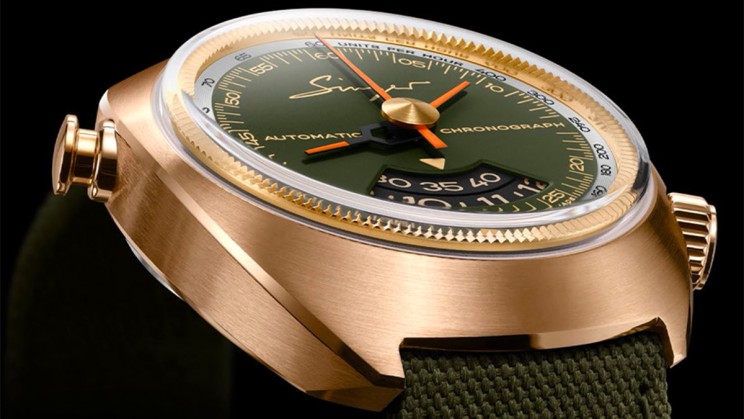
In addition to the bronze case and khaki dial, you’ve added subtle details like this silvery ring on which the 1969 Chronograph’s tachymeter scale is emblazoned…
It’s actually an oyster white ring! I put it there for two reasons. First, for clarity: This chronograph can track events up to 60 hours long. So, I wanted to distinguish the chronograph hour scale from the tachymeter scale.
Secondly, I wanted to elevate the dial. I love the matte khaki grain, but I was afraid that the dial was going to be a bit empty. I wanted to put a little highlight to enrich this layout and oyster white goes very well with khaki and the golden peripheral ring. Plus, this oyster white has a very interesting reflection.
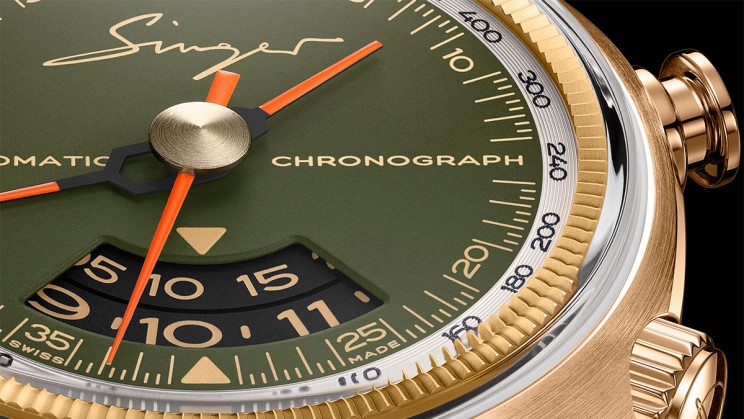
Another detail is that you’ve paired these bronze editions with a khaki “technical textile” strap with Velcro fixation…
Of course, if owners want to, they can have a more traditional strap and buckle. But my idea was for this to be the kind of watch you can wear anytime, anywhere – one that you don't need to worry about. And the Velcro technical textile strap is perfect for this. It provides a snug fit and is very resistant.
I also really wanted to have a feature that is different from anything else that we've done. As a designer, I get bored quite quickly. Because when you launch a new release, for the designer it's something that is already a couple of years old. It can be frustrating to keep seeing the same thing, knowing that you have so much more that is possible. So, I like to animate the collection a little. But it's definitely not the best way of optimising our production!
And for the new silver-dialled editions of the 1969 Chronograph and Timer, you’ve kept the steel bracelet that boasts many impressive design details…
Yes, there are a lot of details to the stainless-steel bracelet! The H-links have brushed faceted surfaces, rounded ends and polished chamfered edges.
Then you have the smooth rounded polished centre links. It also tapers from 22mm at the top down to 18mm. Even the clasp has fine brushing on the upper surface and mirror-polished edges.
But what is interesting is that you can lend your watch to your child or to your companion and it can easily fit their wrist without needing to remove any links because of the micro-adjustment mechanism in the clasp. It allows 20mm of tightening or loosening in 1mm increments to find that perfect fit. So, I know my girlfriend could well steal my watch at some point!
